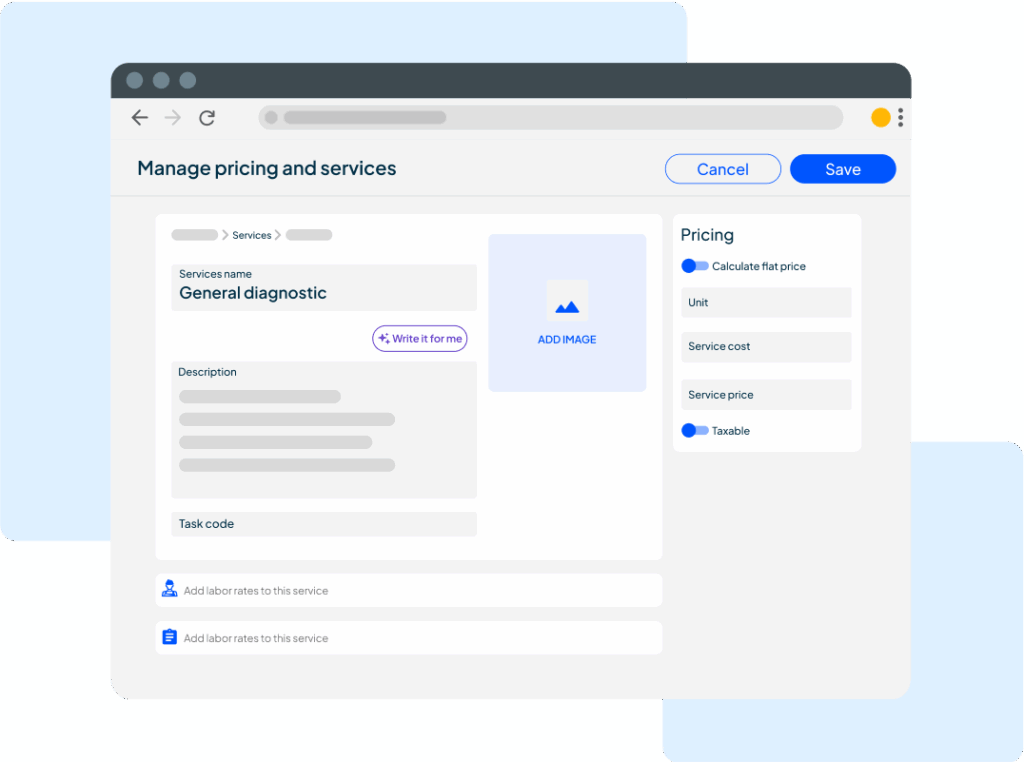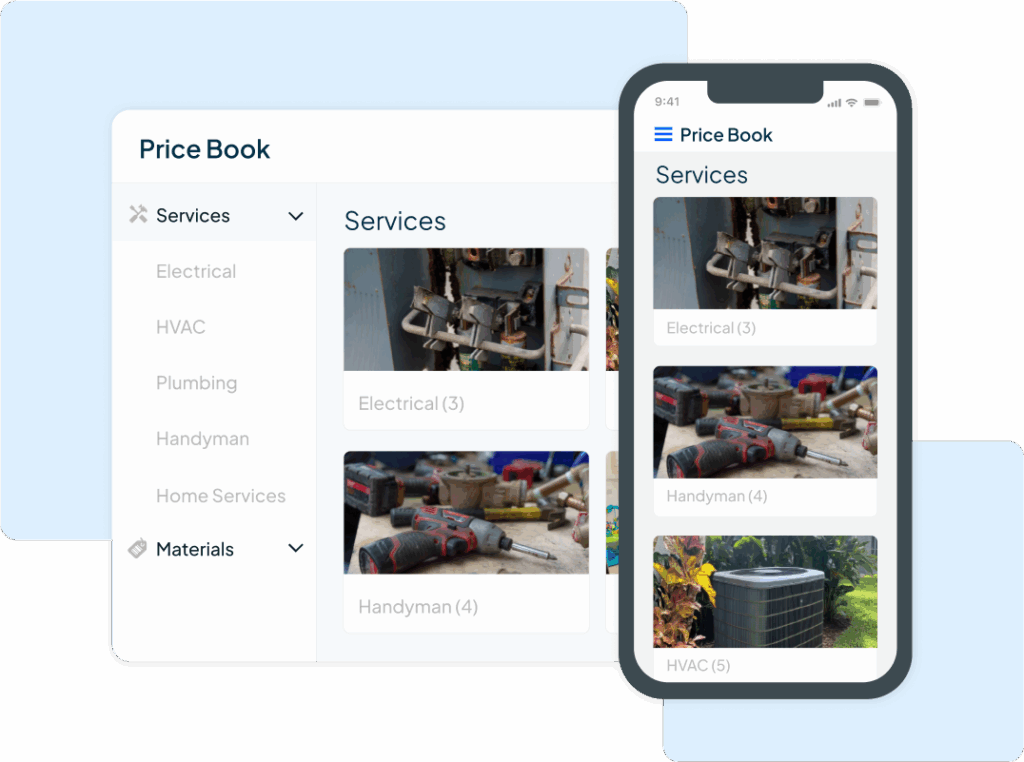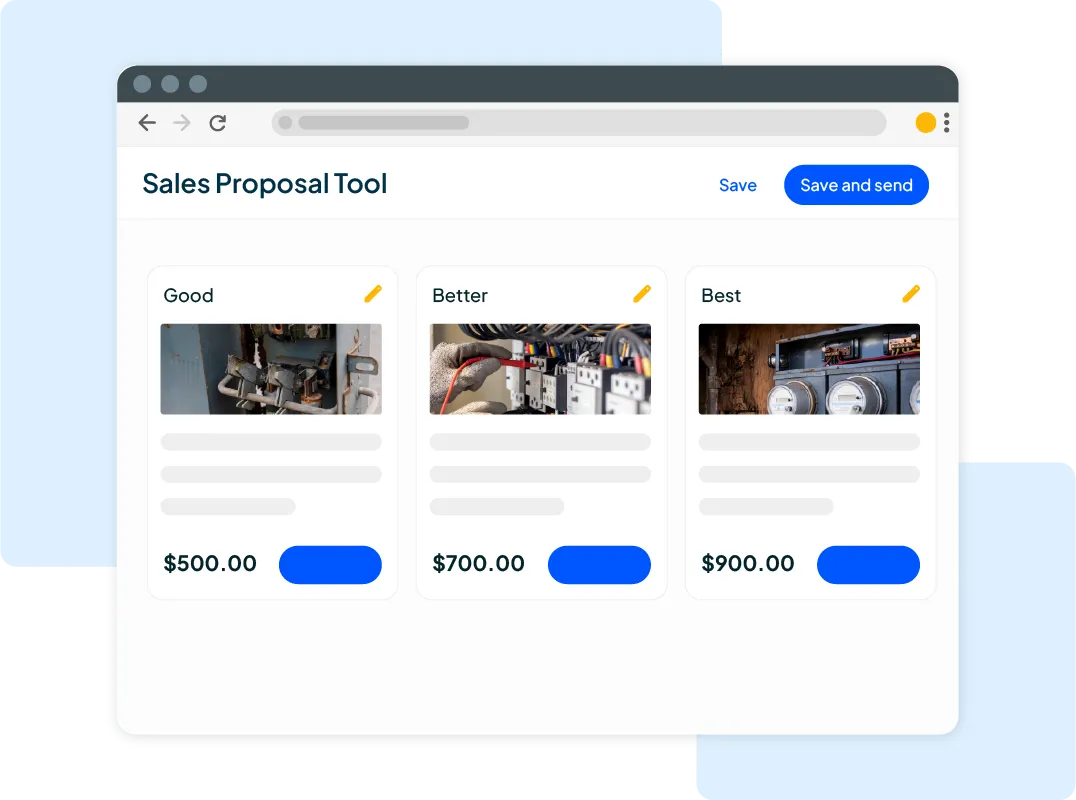Want to win more jobs with less effort?
Grow your business and send quick quotes with our home service software.

Want to see your potential revenue?
See what businesses like yours earn with Housecall Pro in 1 - 2 minutes.

Setting the right prices is key to keeping your electrical business profitable. As costs for materials, permits, and labor continue to shift, you need to know how your rates stack up—and how to build estimates that protect your bottom line.
This guide breaks down current electrician rates, factors that shape those prices, and how to calculate fair estimates for residential and commercial jobs. Whether you’re just starting your business or revisiting your service fees, you’ll find practical strategies and data to help you quote with confidence.
Key takeaways
Here are five quick takeaways to remember when setting your electrician pricing:
Research your market: Compare local rates to stay competitive without undervaluing your work.
Include all costs: Factor in overhead, labor, and materials in every estimate.
Charge for service calls: Use a reasonable call-out fee to cover travel and assessment time.
Plan for emergencies: Charge a premium for urgent or after-hours jobs.
Use digital tools: Electrical contractor platforms like Housecall Pro help you organize quotes and track profitability.
Jump ahead
Here’s what you’ll learn in this guide. Skip ahead to any section using the navigation below.
Average electrician hourly rates
Electricians’ hourly rates can range from $40–$100 depending on factors like location, license level, and experience.* Here’s a look at hourly costs for electricians in 2025:
| Experience Level | Average Hourly Cost |
| Apprentice | $40–60 |
| Journeyman | $60–$90 |
| Master | $90–$100 |
Electrician service call fee
Most electricians also charge a call-out or service call fee to help offset overhead. This fee is billed separately from your hourly rate and typically ranges from $100–$200.
*All pricing data in this guide was sourced from the Bureau of Labor Services, National Electrical Contractors Association (NECA), and reputable trade sites including Angi and HomeAdvisor.
Electrician flat rate pricing
Some electricians use flat rate pricing for standard services like outlet replacements or breaker upgrades. These rates typically range from $150–$600 depending on the job.
Customers like the transparency of flat rate pricing, and it’s an easy way to speed up your quoting process. However, it can eat into your profit margins if a job takes longer than expected. Most pros use a hybrid model—flat rates for routine work and hourly pricing for more complex or diagnostic jobs. Skip to our “How to estimate electrical work” section for guidance on choosing the best pricing model.
Want to set flat rates faster? Download our free flat-rate pricing template to set consistent, profitable rates in minutes.
Electrician labor rates
Labor costs play a major role in your overall pricing, and the rates you offer your team impact both your bottom line and the quality of your work. Most electricians earn between $22 and $38 per hour, though wages vary by skill level, credentials, and location. Offering competitive rates is critical to your business; it helps you attract and retain good workers, build a strong reputation, and maintain service quality as you scale.
Not sure what to charge—or pay? Use our free Electrical Labor Rate Calculator to find your ideal hourly rate fast or learn more in our electrician salary guide.
Additional electrician cost considerations
Many factors affect what you charge for electrical work, and rates often vary from job to job. Here’s what to consider when setting your prices:
- Location: Prices can vary significantly depending on where your business operates. Electricians in large metropolitan areas often charge more to cover higher living costs and longer travel times. When setting your rates, research local averages in your service area to stay competitive while covering expenses.
- Experience level: Apprentice, journeyman, and master electricians should have distinct rate tiers. Make sure your pricing reflects your expertise and certifications. The more experience you have, the more value you bring to a job, and clients are often willing to pay for that.
- Home size and age: Larger homes or older properties can take longer to troubleshoot access, or bring up to code. Allow extra time in your estimates for these jobs so you don’t undercharge.
- Accessibility: Jobs that require work in crawl spaces, attics, or tight areas may take longer and require additional safety precautions. Adjust your rates or add a surcharge for projects that are hard to access.
- Emergencies: After-hours, holidays, and weekend calls should have higher rates to compensate for urgency and scheduling disruptions. Make sure these are rates clear to customers upfront to prevent misunderstandings and maintain transparency.
- Materials: Always clarify if your estimate includes parts, especially on jobs like panel upgrades or rewiring.
Electrician price list for common jobs
Some electrical projects take only a short visit, while others need more time, materials, and planning. Smaller tasks like replacing outlets or repairing minor wiring fall at the lower end of the price range. Larger projects—panel upgrades, whole-home rewiring, or outdoor lighting installs—cost more due to added complexity, materials, and code requirements.
Here’s a general price list to help you estimate costs for common electrical services in 2025.
Pro tip: Use our free Electrical Service Price Calculator to build precise, profitable quotes in minutes.
Small jobs
Quick, straightforward jobs typically require less time and fewer materials. Examples include replacing outlets or switches, installing ceiling fans, and hanging new light fixtures.
Prices for these tasks depend on wiring access, fixture type, and the materials you use.
| Job | Price Range | Factors Affecting Cost |
| Install or replace a switch | $85–$200 | Switch type, wall condition, wiring complexity |
| Install a doorbell, smoke, or carbon monoxide detector | $90–$250 | Hardwired vs. battery-operated, number of devices, location |
| Install or replace a ceiling fan | $140–$350 | Ceiling height, mounting type, wiring complexity |
| Install or replace a light fixture | $150–$6,000 | Fixture type, ceiling height, accessibility, wiring complexity |
| Install or replace an outlet | $200–$300 | Outlet type), wall condition, wiring accessibility |
| Electrical wiring | $1,500–$10,000 | Short runs for small rooms or additions, wire type, accessibility |
Large jobs
Complex projects require more expertise, materials, and time on-site. These include upgrading main panels, whole-house rewiring, and installing electrical systems for additions or remodels. Your prices will likely vary widely depending on home size, permit needs, accessibility, and local code requirements.
| Job | Price Range | Factors Affecting Cost |
| Smart home upgrades | $200–$1,660 | System complexity, number of devices, wiring requirements |
| Install circuit (dedicated line) | $570–$1,000 | Distance to panel, type of circuit, materials required |
| Electrical panel upgrade | $1,200–$2,000 | Panel size, number of breakers, permits, labor complexity |
| Whole-house rewiring | $1,500–$10,000 | Home size, age, material costs, labor hours |
| Install hot tub wiring/conduit | $1,900–$2,400 | Panel capacity, installation difficulty, wiring distance |
| Install outdoor lighting | $2,000–$6,000 | Wiring length, fixture type, and location complexity |
Emergency services
Emergency calls—like urgent repairs, outages, or dangerous electrical issues—require fast responses often outside normal business hours. Electricians typically add $100–$200 to their standard rates for calls during nights, weekends, or holidays to cover the added time and disruption.
About 64% of electrician jobs are routine, meaning emergency calls make up a smaller part of your services. Still, it’s important to price these calls appropriately to protect your time and prevent burnout.
How to estimate electrical work pricing

Accurate pricing protects your bottom line. Each project is unique, but a structured approach helps you quote confidently and cover all your costs. Here’s how to build electrician estimates that reflect real costs and maintain fair profit margins.
Want to skip the math? Use Housecall Pro to automate accurate, consistent quotes for every job.
Step 1: Research local market rates
Start by reviewing what electricians charge in your area. Use online pricing tools, contractor directories, and local trade data to find average rates.
Step 2: Choose a pricing structure
Decide if you’ll use hourly or flat-rate pricing. Hourly rates work well for troubleshooting or small repairs where time varies. Flat-rate pricing is best for routine jobs like outlet installations or ceiling fan replacement, letting you standardize pricing and improve efficiency.
Step 3: Determine overhead costs
Don’t overlook business expenses that aren’t directly tied to a specific job (think insurance, vehicle maintenance, office rent, tools, and administrative costs). Use this formula:
Hourly overhead cost = Total annual overhead total ÷ billable hours
Step 4: Calculate labor costs
Factor in wages, payroll taxes, and benefits for each employee. Here’s a helpful formula:
True Labor Cost = (Wage + Taxes + Benefits) × Hours Worked
Step 5: Set profit margins
After covering labor and overhead, add a service markup to reach your target profit. Remember that profit margin is the share of revenue left after all expenses are paid, while markup is the difference between your costs and the final customer price.
A good target profit margin for electrical business is 10%–20% profit per job, depending on service type and local market conditions. Use this formula to calculate your service markup:
Selling Price = Total Costs ÷ (1 – Desired Profit Margin)
Step 6: Account for job complexity and materials
Estimate time and material costs based on job type. Complex jobs like panel upgrades or rewiring take more time and materials than quick fixture replacements. Adjust pricing for accessibility, home size, and difficulty so you’re not undercharging.
Step 7: Add service call fees
Include a service call fee (typically $100–$200) to cover travel, setup, and initial assessment before the job begins.
Step 8: Set emergency and after-hours premiums
For urgent work, it’s standard to charge an added fee on top of your base rate (typically $100–$200). Be transparent about these rates to avoid surprises and maintain strong customer relationships.
Step 9: Use pricing tools and software
Software makes it easier to create clear, transparent estimates for customers quickly. Estimating tools and templates from Housecall Pro factor in materials, labor, and overhead automatically for faster, accurate, and more consistent pricing.
Step 10: Review and adjust regularly
Track your actual expenses, labor hours, and profit margins each quarter. Adjust your pricing as needed to reflect material cost changes, local demand, and new business goals.
Free download: Use our electrical invoice template to easily bill clients, track hours, and ensure your payments are accurate and professional.
Get In Touch: 858-842-5746
Let us earn your trust
On average, Pros increase monthly revenue generated through Housecall Pro over 35% after their first year.
See plan options and feature breakdown on our pricing page.
Example walkthrough
Let’s walk through these steps using a standard ceiling fan installation as an example.
Step 1–2: Compare market rates
You find that electricians in your area charge about $150–$300 for ceiling fan installations. You decide to use flat-rate pricing for this type of routine job.
Step 3: Determine overhead costs
Your annual overhead (insurance, tools, office rent, vehicle costs, etc.) totals $60,000, and you have 1,500 billable hours per year.
Hourly overhead cost = $60,000 ÷ 1,500 = $40/hour
Step 4: Calculate labor costs
Your technician earns $30/hour, with an additional $5/hour in payroll taxes and $3/hour in benefits.
True Labor Cost = ($30 + $5 + $3) × 2 hours = $76
Step 5: Set profit margins
Now add overhead and labor together:
Total Costs = $76 (labor) + ($40 × 2 hours) overhead = $156
You want a 15% profit margin, so:
Selling Price = $156 ÷ (1 – 0.15) = $183.53
To make pricing cleaner, you might round to $185 flat.
Step 6: Account for materials
Add the cost of wiring, connectors, and hardware—about $25 total.
New Total = $185 + $25 = $210
Step 7: Add service call fee
Include a standard $100 service call fee to cover travel and setup time.
Final Customer Price = $210 + $100 = $310
Step 8–10: Factor in surcharges
If the job is after-hours or in a difficult-to-access location, you might add an extra $100–$150.
Advanced electrician pricing tips
Once you’ve established your base pricing, refining your pricing strategy can boost efficiency and profits. Advanced approaches go beyond hourly rates and material costs. They focus on how you package, present, and adapt your services as market conditions change.
Here’s how you can take your pricing strategy to the next level:
- Bundle services: Combine multiple small jobs into one visit to save travel time, cut operational costs, and increase overall revenue per call.
- Offer strategic discounts: Use limited-time deals or first-time customer promotions to bring in new clients without significantly lowering profit margins.
- Document pricing policies: Clearly outline your rules for estimates, deposits, and cancellations in writing to prevent billing confusion and future disputes.
- Adjust for market trends: Keep an eye on demand for new services, like growing interest in smart home systems or EV charger installations, and update your rates as needed.
- Communicate clearly with customers: Be transparent about your pricing, materials, and potential add-ons. Explaining costs upfront builds trust and reduces surprises.
Explore more electrician checklists and templates for fast, efficient pricing.
How Housecall Pro’s electrician software can help

You don’t have to figure out pricing on your own. Housecall Pro offers digital tools to quote, manage, and adjust your pricing with accuracy and consistency.
Designed specifically for trades professionals, our electrician software helps you simplify your workflow, save time on admin tasks, and maintain consistent profitability. Whether you’re calculating hourly rates or creating detailed project bids, we give you the flexibility to handle it all in one platform.
Here’s how Housecall Pro helps electricians stay organized and profitable:
- Customizable electrician quote templates: Build professional, ready-to-send estimates for small, large, or emergency jobs in minutes. Create and adjust quote templates for different job types, materials, or service areas to keep your pricing consistent and polished.
- Accurate cost calculations: Housecall Pro automatically factors in overhead, materials, and labor so you can calculate true job costs without manual guesswork. This helps you set rates that reflect both value and profitability.
- Service call and premium rate management: Add after-hours, weekend, or emergency fees with a click. You can customize pricing multipliers (like 1.5x or 2x) to simplify quoting for urgent jobs.
- Expense and labor tracking: Track job costs, time, and changes in one simplified dashboard. Over time, you’ll see patterns that help refine your pricing.
- Profit margin insights: Track real-time performance to better understand your electrician salary potential and make informed pricing updates as your business grows.
Ready to take the guesswork out of pricing? Try Housecall Pro today to see how the right software can help you quote faster, track costs, and grow your bottom line.
Pricing data methodology
All pricing data in this guide was compiled from trusted national sources, including the Bureau of Labor Services, National Electrical Contractors Association (NECA), and reputable trade sites including Angi and HomeAdvisor. Rates represent the national average cost for residential and light commercial electrical services and may vary depending on:
- Regional labor markets and local cost of living
- Job complexity, access, and material requirements (e.g., wiring type, panel upgrades)
- Permit fees and inspection requirements
- Experience level, licensing, and business overhead
- Emergency, after-hours, or same-day availability
Always verify costs with local suppliers or municipal electrical authorities, and update your price book quarterly to account for changes in material costs, wage rates, and energy-related supply fluctuations.







